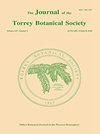阿勒格尼高原公用廊道和河岸林草本层对比与外来植物发生
IF 0.8
4区 生物学
Q4 PLANT SCIENCES
引用次数: 17
摘要
外来植物物种对群落结构和功能的不利影响。为了确定廊道建设对宾夕法尼亚州西北部阿勒格尼高原河岸植被的影响,我们比较了公用廊道和邻近的上游河岸林草本层(所有维管植物高度为1 m)的物种组成和丰富度,并验证了公用廊道是外来维管植物入侵邻近河岸林的焦点的假设。对比了17个样地公用廊道和相邻河岸林的植物物种丰富度和植被覆盖度、生长形式覆盖度、外来植物物种丰富度和覆盖度以及微生境组分(露地、岩石、凋落叶、原木、苔藓植物)的覆盖度。聚类分析表明,廊道和河岸林草本层物种组合在组成上存在差异。廊道的草本层盖度和物种丰富度显著高于河岸林(P < 0.05)。走廊草本层盖度以蕨类、禾本科植物和草本植物共同占主导地位;蕨类植被占河岸森林的多数。廊道的外来植物盖度明显大于河岸林。外来植物物种丰富度和覆盖度与廊道露地土壤、漫滩宽度和活动河道宽度呈显著正相关,与河岸林凋落物覆盖度呈显著负相关。考虑到廊道中大部分外来植物不耐阴,且不存在于河岸林中,我们认为开放式廊道主要是作为外来植物的栖息地避难所,而不是入侵焦点。本文章由计算机程序翻译,如有差异,请以英文原文为准。
Herbaceous layer contrast and alien plant occurrence in utility corridors and riparian forests of the Allegheny High Plateau
communities by alien plant species that can adversely affect community structure and function. To determine how corridor establishment influences riparian vegetation of the Allegheny High Plateau of northwestern Pennsylvania, we compared the species composition and richness of the herbaceous layer (all vascular plants s 1 m tall) of utility corridors and adjacent headwater riparian forests, and tested the hypothesis that utility corridors serve as foci for the invasion of adjacent riparian forest by alien vascular plants. We contrasted plant species richness and vegetative cover, cover by growth form, species richness and cover of alien plants and cover of microhabitat components (open soil, rock, leaf litter, log, bryophyte) in utility corridors and adjacent riparian forest at 17 sites. Cluster analysis revealed that herbaceous layer species assemblages in corridors and riparian forest were compositionally distinct. Herbaceous layer cover and species richness were significantly (P s 0.05) greater in corridors than in riparian forest. Fern, graminoid, and forb species co-dominated herbaceous layer cover in corridors; fern cover dominated riparian forests. Cover of alien plants was significantly greater in corridors than in riparian forest. Alien plant species richness and cover were significantly and positively correlated with open soil, floodplain width, and active channel width in corridors but were significantly and negatively correlated with litter cover in riparian forest. Given that the majority of alien plant species we found in corridors were shade-intolerant and absent from riparian forests, we conclude that open utility corridors primarily serve as habitat refugia, rather than as invasion foci, for alien plant species in riparian forests of the Allegheny High Plateau.
求助全文
通过发布文献求助,成功后即可免费获取论文全文。
去求助
来源期刊
CiteScore
0.70
自引率
0.00%
发文量
16
审稿时长
>12 weeks
期刊介绍:
The Journal of the Torrey Botanical Society (until 1997 the Bulletin of the Torrey Botanical Club), the oldest botanical journal in the Americas, has as its primary goal the dissemination of scientific knowledge about plants (including thallopyhtes and fungi). It publishes basic research in all areas of plant biology, except horticulture, with an emphasis on research done in, and about plants of, the Western Hemisphere.

 求助内容:
求助内容: 应助结果提醒方式:
应助结果提醒方式:


